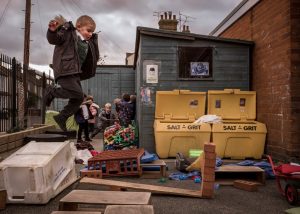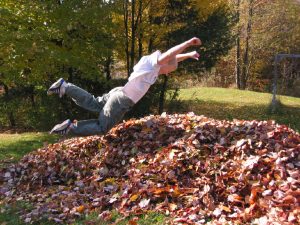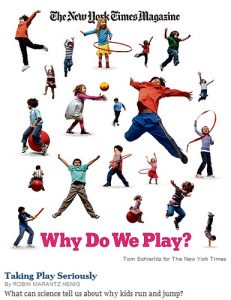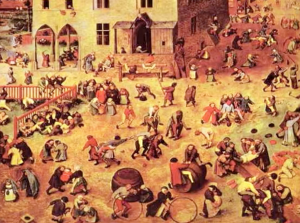It has been said that “All work and no play makes Jack a dull boy.” Does it only mean that Jack is bored if he does not get to play, or much more? The eminent play scholar, Joe Frost, in his compelling book, “A History of Childhood Play and Play Environments” (1) tellingly shows that the diminution, modification, and/or disappearance of play during the latter twentieth and beginning of the twenty first century is presenting a crisis threatening our societal overall welfare, likely to last for many generations.
Benefits of Play
If the absence of play has such serious consequences, then it must have many benefits if it is applied.
Before we talk about the benefits of play we need to define what it is. The Oxford Dictionary defines play as to “engage in activity for enjoyment and recreation rather than a serious or practical purpose” (like jumping into a pile of dry leaves). It adds, to “amuse oneself by engaging in imaginative pretense” such as in role-playing. But play is more than just fun. It has many practical benefits.
1. Play makes you more adaptable and is important for our survival. Studies of rats and some primates show that rough-and-tumble play among juveniles improves social competence, cognition, and emotional regulation later in life. Most critically, such play makes animals better able to respond to unexpected situations. (2)
2. Play helps children develop new competencies that lead to enhanced confidence and the resiliency they will need to face future challenges(3)
3. Play contributes to the full emotional development of the child.(4)
4. Play helps children cope better with stress.(5)
5. Undirected play allows children to learn how to work in groups, to share, to negotiate, to resolve conflicts, and to learn self-advocacy skills.(6)
6. Encouraging unstructured play may be an exceptional way to increase physical activity levels in children, which is one important strategy in the resolution of the obesity epidemic.(7)
7. Play actually has an impact on the brain. When it comes to brain development, time in the classroom may be less important than time on the playground.
“The experience of play changes the connections of the neurons at the front end of your brain,” says Sergio Pellis, a researcher at the University of Lethbridge in Alberta, Canada. “And without play experience, those neurons aren’t changed,” he says. It is those changes in the prefrontal cortex during childhood that help wire up the brain’s executive control center, which has a critical role in regulating emotions, making plans and solving problems, Pellis says. So play, he adds, is what prepares a young brain for life, love and even schoolwork.
8. When parents play with their 2- and 3-year olds, it contributes to their child’s language and cognitive development.(8)
 9. There is a biological component to play; animals play in nature.
9. There is a biological component to play; animals play in nature.
Children are natural players, right from the beginning. “It’s hard to imagine when an infant or a toddler isn’t playing,” they don’t have to be taught to play. They do it naturally. The sad thing is that the older they get, the less they play.
10. Perhaps above all, play is a simple joy that is a cherished part of childhood.
Play is not just for kids
What was your favorite way to play as a child? And how do you like to play now?
The 17th February 2008 issue of the New York Times Magazine contained many articles on the subject of play. On its cover is a picture of children playing (see picture on the left). What’s interesting is that there was not a single picture of an adult playing. Is it so rare that we no longer associate adults with play? In contrast, the picture on the right shows adults playing in an courtyard in 15th Century Europe.
Humans are capable of play well into adulthood as a result of neoteny – the retention of immature qualities into adulthood – and so should do so. The human brain, owing to neoteny, does not complete the development of its networks till relatively late in life. It remains plastic—its ability to form new networks—far longer than the brains of chimpanzees and other creatures. The delay in maturation affords the human brain allows us to keep on learning well into adulthood. It is no accident that unusually creative brains often are associated with playful, ever-curious immature and playful personalities. Indeed, curious brains manufacture experience; we call it play. Playful curiosity is a mechanism by which brains organize their connections. Brains learn as they play.(9)
It’s never too late to develop your playful, humorous side. If you find yourself limiting your playfulness, it’s possible that you’re self-conscious and concerned about how you’ll look and sound to others when you attempt to be lighthearted. Fearing rejection, embarrassment or ridicule when attempting to be playful is an understandable fear. Adults are often worried that being playful will get them labeled as childish. But what is so wrong with that?
LEGO Play Well Report 2018
(LEGO means “play well” in Danish)

Play is its own reward. We do it because it feels good. The urge to play is nature’s way of helping us make sense of the world and our place in it. Through play we learn how our minds and bodies work and discover how others think and feel. Through play we come to know what it means to belong, to be loved and feel happiness.
Sharing play is where the real benefits for children and parents come. (Lego)
The report reveals a strong link between the hours spent playing together and the happiness of families. Playing together makes families happier, closer and less stressed – but over a third (38%) admit they struggle to prioritise playtime due to hectic daily schedules of both parents and their children. When families do get together to play, six in 10 (61%) parents admit they tend to get distracted by life’s other demands, such as work, house chores and their ever-present smartphones. Alarmingly, one in five children (17%) say they are too busy for play, with four out of five (81%) wishing their parents would play with them more.
16 Types of Play
Bob Hughes in his Taxonomy of Play Types (2002) identified sixteen different types of play for the purposes of adults who study and facilitate play. It is examined in far more detail in his 1996 book A Playworker’s Taxonomy of Play Types. Children need to experience the full range of play types during their childhood in order to attain and maintain a state of wellbeing. Where children fail to do this they may be said to be suffering from a play deficit, and are likely to experience lasting damage.
Play Deprivation and Deficit
In their study of young murderers(10), Brown and Lomax looked at the link between play and neuroses in a different way – namely, play as a causal factor. Their study was prompted by Brown’s earlier involvement in the case of the notorious murderer, Charles Whitman. In 1966 Whitman, an apparently ‘normal’ person, went into the tower overlooking the campus of the University of Texas, Austin, from where he shot and killed 17 people, wounding a further 41. Stuart Brown compiled the behavioural data for the team charged with the task of searching for the causes in Whitman’s life. That team of experts came from a number of different specialist fields, and the idea was for them to reach a consensus view on the reasons for Whitman’s actions. Their conclusions were stark, but nevertheless significant for any study of play deprivation:
‘A lifelong lack of play deprived him of opportunities to view life with optimism, test alternatives, or learn the social skills that, as part of spontaneous play, prepare individuals to cope with life stress. The committee concluded that lack of play was a key factor in Whitman’s homicidal actions – if he had experienced regular moments of spontaneous play during his life, they believed he would have developed the skill, flexibility, and strength to cope with the stressful situations without violence.(11)
Deprivation and bias in children’s play are far more widespread than society acknowledges, and far more damaging. Long ago parents placed fewer restrictions on their children’s play. For example, parents would warn children not to play on the road. Today there are much more restrictions as there are more reasons to make parents fearful. This includes falls, injuries, and kidnapping. Some parents forbid their children from playing outdoors simply because the sun might ruin their child’s good complexion.
 Educators in Britain, after decades spent in a collective effort to minimize risk, are now, cautiously, getting into the business of providing it. Four years ago, for instance, teachers at the Richmond Avenue Primary and Nursery School looked critically around their campus and set about, as one of them put it, “bringing in risk.”
Educators in Britain, after decades spent in a collective effort to minimize risk, are now, cautiously, getting into the business of providing it. Four years ago, for instance, teachers at the Richmond Avenue Primary and Nursery School looked critically around their campus and set about, as one of them put it, “bringing in risk.”
Out went the plastic playhouses and in came the dicey stuff: stacks of two-by-fours, crates and loose bricks. The schoolyard got a mud pit, a tire swing, log stumps and workbenches with hammers and saws.(12)
HOW TO PLAY WITH YOUR CHILD
Here are some helpful tips to encourage play:
- Establish regular play times. It may be for twenty minutes before dinner every night or every Saturday morning, for example. Remember, this time spent playing together is benefiting both of you.
- Give your child your undivided attention. Turn off the TV and your cell phone and make the time to play with your child without distraction. Having your undivided attention makes your child feel special.
- Get down to your child’s level. That may mean getting down on your knees or sitting on the floor. Match your child’s intensity during play—if your child is loud and energetic, be loud and energetic, too.
- Embrace repetition. It may be boring to you, but it’s not to your child. Children learn through repetition. Let your child play the same game over and over. Your child will move on when he or she is ready.
- Let your children take the lead. Become part of their game rather than trying to dictate the play. In pretend play, let your child call the shots, make the rules, and determine the pace of play. Ask questions and follow along—you’ll likely get drawn into imaginative new worlds that are fun for you, too.
- Don’t force play or try to prolong a game. The best way to teach a new skill is to show children how something works, then step back and give them a chance to try. When your child is tired of an activity, it’s time to move on to something new.
- Make play age-appropriate and consider safety.If a game is too hard or too easy, it loses its sense of pleasure and fun. Help your child find age-appropriate activities and understand any safety rules for play. Nothing ruins a fun game faster than a child getting hurt.
Last Words
Children are not outdoors as much as they should be. What kind of memories are being created for our children today? Be intentional as a parent about making sure that your children have time to play outdoors. Before it was part of the day. Now you need to make sure that it happens. You have to take the time outside to play by themselves.
References
(1) A History of Childhood Play and Play Environments – A contemporary Child-saving Movement Joe L. Frost New York, NY: Routledge, 2010.
(2) Sergio M. Pellis, Vivien C. Pellis and Brett T. Himmler How Play Makes for a More Adaptable Brain: A Comparative and Neural Perspective. American Journal of Play, v7 n1 p73-98 Fall 2014
(3) Hurwitz SC. To be successful: let them play! Child Educ.2002/2003;79 :101– 102
(4) Erickson RJ. Play contributes to the full emotional development of the child. Education.1985;105 :261– 263
(5) Band EB, Weisz JR. How to feel better when it feels bad: children’s perspectives on coping with everyday stress. Dev Psychol.1988;24 :247– 253
(6) McElwain EL, Volling BL. Preschool children’s interactions with friends and older siblings: relationship specificity and joint contributions to problem behaviors. J Fam Psychol.2005;19 :486– 496
(7) Burdette HL, Whitaker RC. Resurrecting free play in young children: looking beyond fitness and fatness to attention, affiliation, and affect. Arch Pediatr Adolesc Med.2005;159 :46– 50
(8) Tamis-LeMonda CS, Shannon JD, Cabrera NJ, Lamb ME. . Child Dev.2004;75 :1806– 1820
(9) Amihud Gilead. Neoteny and the Playground of Pure Possibilities. International Journal of Humanities and Social Science Vol. 5, No. 2; February 2015
(10) Brown, S. and Lomax, J. (1969) A pilot study of young murderers. Hogg Foundation Annual Report. Austin, Texas
(11) NIfP (2011) Play deprived life – devastating result: a tortured soul explodes. [Internet], National Institute for Play. Available from: www.nifplay.org/whitman.html)
(12) https://www.nytimes.com/2018/03/10/world/europe/britain-playgrounds-risk.html
Written by Parcsen Loke. Parcsen Loke is the Deputy Head of Programmes and Development at Centre for Fathering. He is married and has 3 children, ages 26, 24, and 13, with his wife Kelly.




